What Happens If Wood Conditioner Left On Too Long?
While wood conditioner helps even out the absorption of liquids across a wood surface, it requires proper curing time. If you’re applying wood conditioner to prepare a wooden surface for stain or paint, it’s important not to leave the conditioner on too long.
But what happens when the wood conditioner is left on too long? If you leave the wood conditioner on too long before wiping away the excess, several unwelcome results can occur:
- Uneven absorption will lead to uneven stains
- Residue can build up and be hard to remove
- Raised wood grain can distort the final finish
That’s why you need to time the dwelling period properly. Removing excess conditioner helps ensure a smooth, even finish on the treated wood.
What Happens When Wood Conditioner Left On Too Long?
Conditioners left more than the manufacturer-recommended dwell time are generally considered overkill. But what would happen if the wood conditioner was left too long?
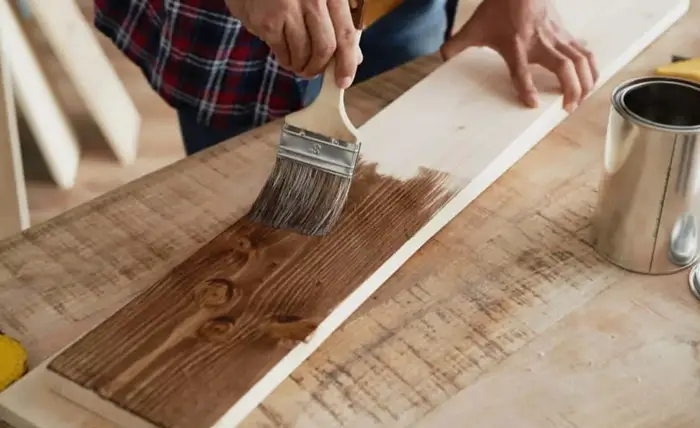
Uneven Staining
If you leave the wood conditioner on too long, you may experience uneven staining of the wood surface. As the conditioner absorbs and dries, some areas of the wood will absorb more than others, leaving patchy, wet or dry spots.
Thus, these unevenly conditioned areas will take on different amounts of stain, resulting in an inconsistent finish with dark and light spots.
Builds Up Residue
Allowing the wood conditioner to sit for an extended period will allow some of its solvents to evaporate. The resins and oils build up as a sticky film on the surface. This residue is difficult to remove, preventing proper penetration and bonding of future coatings like stains and finishes.
The residue can also attract dust and debris, further complicating the application of the intended finish. Thorough sanding or scraping may be required to remove excess buildup before reconditioning the wood.
Raised Grain And Texture Changes
If you use a water-based wood conditioner and allow it to sit and penetrate the wood fibers, it can cause the wood grain to swell and rise. That can distort the surface texture, particularly when used on softwoods with longitudinal tracheids transporting the conditioner faster.
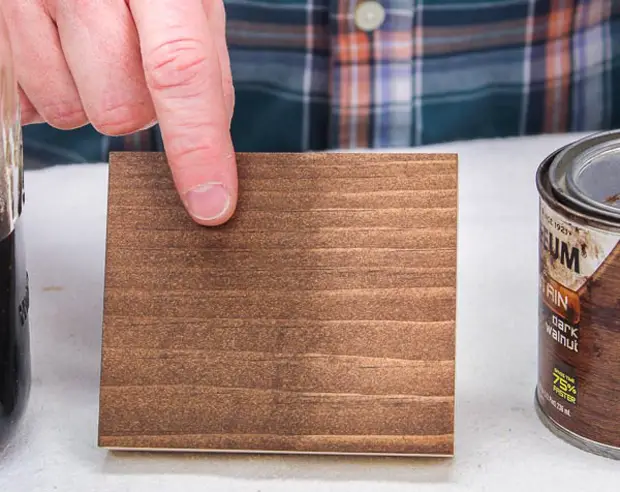
The longer the conditioner is left on, the more pronounced the raised grain will be. This change in texture can make the finish coat appear uneven or streaky, especially with pigmented stains.
Difficulty In Achieving Desired Finish
The wood conditioner left on too long can also lead to difficulties in achieving an even and consistent finish coat. As mentioned, issues like uneven staining, residue buildup, and raised grain can make it hard for stain or topcoat to adhere appropriately and uniformly across the surface.
Patches may appear lighter or darker, and gloss or sheen may vary.
Impact On Wood’s Structural Integrity
Another possible outcome of leaving the conditioner on for an extended period is damage to the wood structural level. It can degrade the lignin that binds the cellulose fibers.
The solvents in the conditioner will continue to break down the lignin that gives wood its rigidity. This degradation can make the wood more susceptible to warping, cracking, or splintering over time.
The conditioner can also penetrate the wood deeper, compromising its structural integrity. However, these structural impacts are generally only a risk if the conditioner is left on the wood for days rather than hours.
Reduced Effectiveness Of Future Treatments
Once excessive residue and buildup form from the conditioner left on too long, it becomes more difficult for future treatments to penetrate and bond with the wood properly. The sticky residue acts as a barrier, reducing the ability of stains and finishes to work their way into the wood’s pores.
That decreased penetration and bond makes future treatments less effective at protecting or enhancing the appearance of the wood on a long-term basis.
How Long You Can Leave Wood Conditioner On?
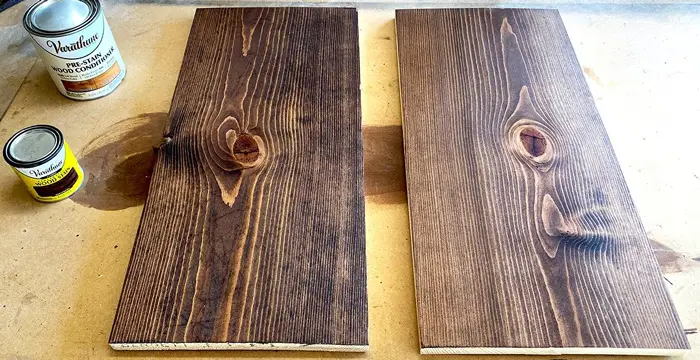
How long you need to wait depends on the brand, product type and the manufacturer-recommended cure time.
- Some recommend 5-15 minutes, while others advise you to wait over 8 hours.
- Conditioners should generally be left on long enough to soak into the wood fibers and form a protective coating.
- Typically, oil-based conditioners need 10 minutes to 24 hours of dwell time on the surface to properly cure.
- Water-based wood conditioners require less time, between one and 10 minutes, with some requiring as little as 1-5 minutes.
As mentioned above, the time you can leave the wood conditioner on varies depending on several factors. They include:
Conditioner Brand and Quality
Typically, each brand has its own recommended dwelling time. Higher-quality conditioners formulated by reputable brands such as Minwax and Rust-Oleum tend to have superior penetration. They provide a longer window before residue builds up and issues occur.
Lower quality or generic conditioners such as HomeChum or Ramax may require significantly less time before they sit too long and begin to cause problems.
Unlike no-name products, conditioners from top brands may allow twice as long on the wood. The formulation, including the ratio of solvents to oils in the conditioner, also affects how briskly it penetrates and dries.
Wood Type and Porosity
When it comes to wood-liquid relations, the wood type and porosity have the biggest impact. Softwoods like pine and fir absorb conditioner faster due to their larger pores, so less time is needed before excessive residue builds up.
Hardwoods like oak, maple, and cherry have smaller pores. While they might not require conditioning, if applied, they may require up to twice as long for full penetration before residue forms. Highly porous woods can handle even less time before the conditioner sits too long.
Environmental Conditions
Conditions like temperature and humidity also affect how the wood absorbs and the conditioner evaporates. In warmer, drier conditions with lower relative humidity, the conditioner penetrates and dries more quickly.
It may require additional time in colder, more humid environments before excess builds up on the surface.
How Do You Fix Issues That Arise After Wood Conditioner Left On Too Long
Here are a few options to remedy issues that may have arisen after the wood conditioner left on too long.
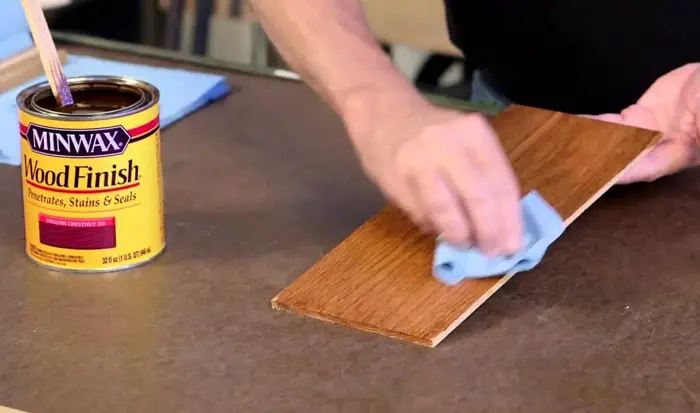
Sand And Refinish
- Using an orbital sander and sanding the wood surface with 120 or 150-grit sandpaper is often the most effective first step. You’ll likely need to completely sand through any stained areas to restore an even appearance.
- Once sanded, reapply the wood conditioner in a thin, even coat and allow the recommended time to penetrate before finishing.
- Then, apply fresh stain and topcoat.
Seek Professional Help If Needed
If excessive conditioner residue has built up or the wood’s structural integrity may be compromised, seeking help from a professional finisher may be advisable. They have the specialized tools, experience, and products to restore wood that has been overly appropriately conditioned.
This often involves more aggressive methods like power planing, wood filling, and intensive sanding, followed by refinishing.
How Do You Know If Wood Conditioner Was Left On Too Long
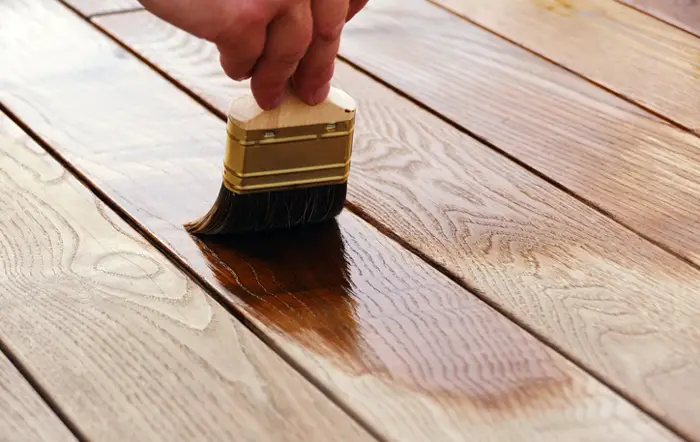
- The most obvious sign that the wood conditioner was left on too long is an uneven appearance to the wood surface.
- Raised or swollen grain will also be visible, distorting the texture of the wood. If staining was attempted, uneven coloring and variations in how dark the stain penetrated could show the conditioner was not absorbed evenly.
- You can also check for blotchy, streaky, or inconsistent finished appearance overall, which is a clear sign the wood was overly conditioned.
- The tactile cues from the wood surface can also confirm if the conditioner was left for an excessive duration.
- Rub your hand along the grain and feel for rough, bumpy, raised, or swollen grain areas. If present, the conditioner likely sat past the point of full penetration.
- Overly conditioned wood may even feel slightly soft or weakened when handling, indicating potential damage to the wood’s structural lignin.
FAQs
Here are some common questions and answers about leaving wood conditioner on too long:
Q: Can You Skip Using A Wood Conditioner?
Yes, wood conditioner can be skipped when staining or finishing wood. However, using a pre-stain conditioner typically yields a smoother finish, especially with dark stains on softwood.
Q: Can I Let The Wood Conditioner Sit Overnight?
No, wood conditioners should not be left on the wood for longer than a few hours at most. Leaving it on overnight risks damage to the wood from prolonged exposure to the conditioner solvents. There are also potential issues with the finish from excess buildup of conditioner residue.
Conclusion
Wood conditioner is an essential step in prepping wood for staining or finishing. But it must be done correctly, or the outcome could be disastrous. The time it takes to dwell on the wood surface varies depending on the type of conditioner and wood type.
Leaving it on too long can result in uneven absorption, residue buildup, raised wood grain, and difficulty achieving a desired finish. It can also degrade the wood’s lignin, leading to warping, cracking, or splintering. Removing excess conditioner promptly helps ensure a smooth, even finish on the treated wood.




